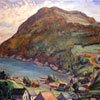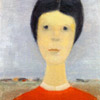artists
Jean Paul Lemieux (1904 - 1990)
Jean Paul Lemieux was born in Québec City, he was raised in Québec City until 1916, when his family moved to Berkeley, California. In 1917, the family returned to Québec and settled in Montréal. From 1926 to 1934, Lemieux studied under Edwin Holgate at the École des Beaux-Arts de Montréal (Montréal School of Fine Arts). In 1929, he traveled to Europe with his mother. In Paris, he met Clarence Gagnon, before returning to Montreal to complete his studies at the Ecole des Beaux Arts from 1930 to 1934. Lemieux took teaching positions from 1934, first at the École des Beaux-Arts de Montréal, then in 1935 at the École du meuble (Furniture School). In 1937, he moved to Québec City and taught at the École des Beaux-Arts de Québec until his retirement in 1965. His connections at that period include other major artists associated with these schools, such as Alfred Pellan and Paul-Émile Borduas. His early tendency to a geometric and decorative approach led him to an ever greater simplification that was especially noticeable in a mural of the mid-1950s, Medicine in Quebec City in which a group of figures is displayed in a flattened manner against an architectural background. Jean Paul Lemieux received several awards for his works, including the Louis-Phillipe Hébert prize in 1971 and the Molson Prize for the Canada Council for the Arts in 1974. In 1968, he became a Companion of the Order of Canada. He was also a member of the Royal Canadian Academy. In 1997, he was posthumously made a Grand Officer of the National Order of Quebec.
| Port-au-Persil | Hélène | |
|---|---|---|
|
|

